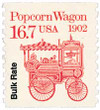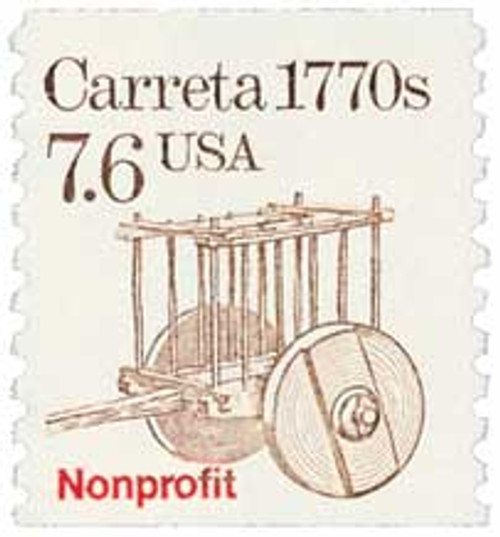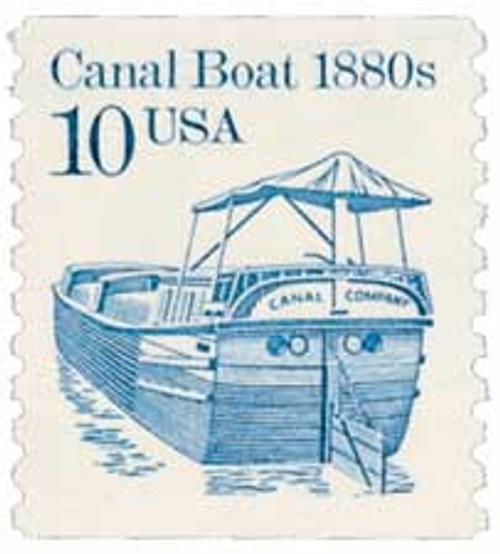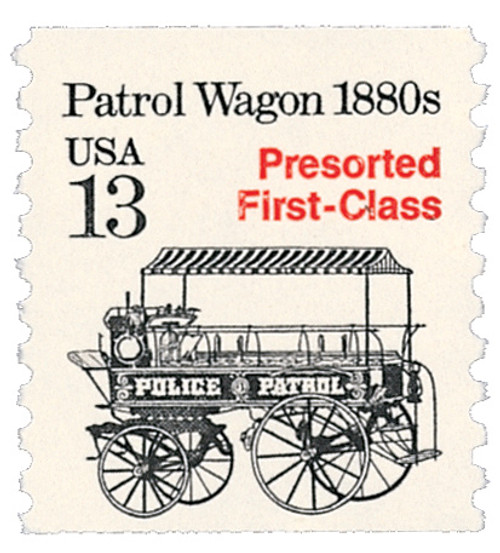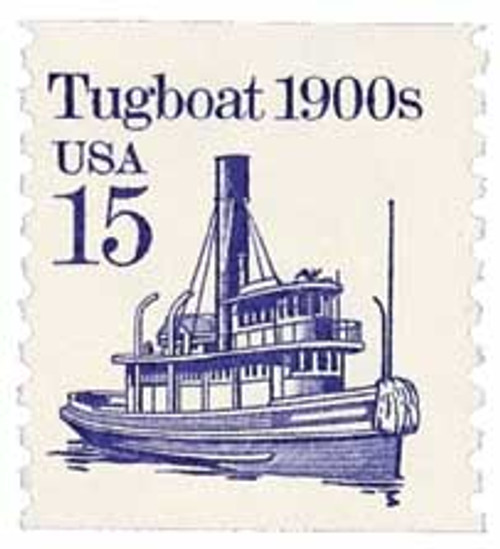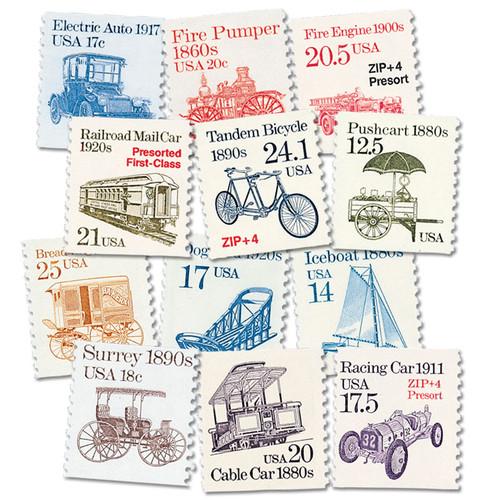
# 2261 - 1988 16.7c Transportation Series: Popcorn Wagon, 1902
U.S. #2261
1988 16.7¢ Popcorn Wagon, 1902
Transportation Series
- 33rd stamp in Transportation Series
- First in series issued only with a precancel
Stamp Category: Definitive
Series: Transportation
Value: 16.7¢, the bulk mail rate
First Day of Issue: July 7, 1988
First Day City: Chicago, Illinois
Quantity Issued: 523,975,000
Printed by: Bureau of Engraving and Printing
Printing Method: Engraved
Format: Coils of 500 and 3,000
Perforations: 10 vertical
Color: Rose
Why the stamp was issued: This stamp was issued to replace the 1985 14¢ Iceboat stamp to cover the basic bulk mail rate.
About the stamp design: Lou Nolan created the image for this stamp based on a catalog image of the Cretors No. 1 Wagon, Model 1902. Charles C. Cretors of Chicago, Illinois is considered the father of the modern popcorn business. The wagon has a glass case on the right side containing a popcorn pan over a batch of freshly-popped popcorn. On the left side under the canopy, the “Tosty Rosty” clown is turning the crank on the peanut roaster.
Special design details: This stamp has a “Bulk Rate” precancel. Precancels are stamps canceled before being sold, to make mailing faster and cheaper for customers with large amounts of mail. Bulk mailers use precancels, then pre-sort their mail and save money.
First Day City: The First Day ceremony for this stamp was held at the Chicago Main Post Office. Representatives from C. Cretors and Company were present and a number of original popcorn wagons were displayed at the event. Cretors also brought functioning modern popper offering fresh popcorn to attendants. Even the first-day program resembled a popcorn box.
Unusual fact about this stamp: Imperforate errors exist.
About the Transportation Series: On May 18, 1981, the USPS issued the first stamp in the Transportation Series, US #1907, picturing the Surrey, a doorless four-wheeled carriage. For the first time in US history, a coil stamp featured its own unique design rather than simply copying that of the current definitive stamp. Over 50 more coil stamps would be issued over the course of the next 15 years, each picturing a different mode of transportation. All of these types of transportation were used since American independence.
The various denominations provided face values to exactly match the rates for several categories of Third-Class mail (bulk rate and quantity-discounted mail). As the rates changed, new stamps with new values were added. Never before had a stamp series included so many fractional cent values.
The Bureau of Engraving and Printing printed most of the stamps in the Transportation Series, although private contractors printed a few. All but a few of the later stamps were produced by engraved intaglio. Differences in precancels, tagging, paper and gum provide a large number of varieties.
Scott Catalog separates the Transportation stamps into four groups. The stamps in the first group (#1897-1908) generally have the denomination in small type with a “c” next to it. These stamps were printed on the Cottrell rotary press, which joined together two plates to make a sleeve. The gaps between these plates created depressions where ink would collect and create joint lines on the stamps. Later issues were printed on a different press and didn’t have these joint lines.
The second group (#2123-36) had larger numbers with no “c.” The third group (#2252-66) was similar in appearance to the second group, but service inscriptions were added to the designs. These stamps also used a variety of paper and gum as well as different types of tagging. The fourth group (#2451-68) marked the end of fractional values. Now bulk mailers would use either the 5¢ or 10¢ stamp and then pay the difference from the actual postage rate.
The last stamp in the Transportation Series, the 20¢ Cog Railway, was issued on June 9, 1995, at the TEXPEX ’95 stamp show in Dallas, Texas. This marked the end of the largest US definitive series up to that time. Three new series would eventually replace it – American Transportation, American Culture, and American Scenes. Additionally, the Great Americans would go on to become the largest American definitive series.
History the stamp represents: In 1893, C.C. Cretors, the father of the modern popcorn industry, created the first wagon to be used solely for vending popcorn. Painted in a rich red with gilt accents, brass trim, and beveled glass, this handsome wagon was the first totally self-contained unit as well.
U.S. #2261
1988 16.7¢ Popcorn Wagon, 1902
Transportation Series
- 33rd stamp in Transportation Series
- First in series issued only with a precancel
Stamp Category: Definitive
Series: Transportation
Value: 16.7¢, the bulk mail rate
First Day of Issue: July 7, 1988
First Day City: Chicago, Illinois
Quantity Issued: 523,975,000
Printed by: Bureau of Engraving and Printing
Printing Method: Engraved
Format: Coils of 500 and 3,000
Perforations: 10 vertical
Color: Rose
Why the stamp was issued: This stamp was issued to replace the 1985 14¢ Iceboat stamp to cover the basic bulk mail rate.
About the stamp design: Lou Nolan created the image for this stamp based on a catalog image of the Cretors No. 1 Wagon, Model 1902. Charles C. Cretors of Chicago, Illinois is considered the father of the modern popcorn business. The wagon has a glass case on the right side containing a popcorn pan over a batch of freshly-popped popcorn. On the left side under the canopy, the “Tosty Rosty” clown is turning the crank on the peanut roaster.
Special design details: This stamp has a “Bulk Rate” precancel. Precancels are stamps canceled before being sold, to make mailing faster and cheaper for customers with large amounts of mail. Bulk mailers use precancels, then pre-sort their mail and save money.
First Day City: The First Day ceremony for this stamp was held at the Chicago Main Post Office. Representatives from C. Cretors and Company were present and a number of original popcorn wagons were displayed at the event. Cretors also brought functioning modern popper offering fresh popcorn to attendants. Even the first-day program resembled a popcorn box.
Unusual fact about this stamp: Imperforate errors exist.
About the Transportation Series: On May 18, 1981, the USPS issued the first stamp in the Transportation Series, US #1907, picturing the Surrey, a doorless four-wheeled carriage. For the first time in US history, a coil stamp featured its own unique design rather than simply copying that of the current definitive stamp. Over 50 more coil stamps would be issued over the course of the next 15 years, each picturing a different mode of transportation. All of these types of transportation were used since American independence.
The various denominations provided face values to exactly match the rates for several categories of Third-Class mail (bulk rate and quantity-discounted mail). As the rates changed, new stamps with new values were added. Never before had a stamp series included so many fractional cent values.
The Bureau of Engraving and Printing printed most of the stamps in the Transportation Series, although private contractors printed a few. All but a few of the later stamps were produced by engraved intaglio. Differences in precancels, tagging, paper and gum provide a large number of varieties.
Scott Catalog separates the Transportation stamps into four groups. The stamps in the first group (#1897-1908) generally have the denomination in small type with a “c” next to it. These stamps were printed on the Cottrell rotary press, which joined together two plates to make a sleeve. The gaps between these plates created depressions where ink would collect and create joint lines on the stamps. Later issues were printed on a different press and didn’t have these joint lines.
The second group (#2123-36) had larger numbers with no “c.” The third group (#2252-66) was similar in appearance to the second group, but service inscriptions were added to the designs. These stamps also used a variety of paper and gum as well as different types of tagging. The fourth group (#2451-68) marked the end of fractional values. Now bulk mailers would use either the 5¢ or 10¢ stamp and then pay the difference from the actual postage rate.
The last stamp in the Transportation Series, the 20¢ Cog Railway, was issued on June 9, 1995, at the TEXPEX ’95 stamp show in Dallas, Texas. This marked the end of the largest US definitive series up to that time. Three new series would eventually replace it – American Transportation, American Culture, and American Scenes. Additionally, the Great Americans would go on to become the largest American definitive series.
History the stamp represents: In 1893, C.C. Cretors, the father of the modern popcorn industry, created the first wagon to be used solely for vending popcorn. Painted in a rich red with gilt accents, brass trim, and beveled glass, this handsome wagon was the first totally self-contained unit as well.






